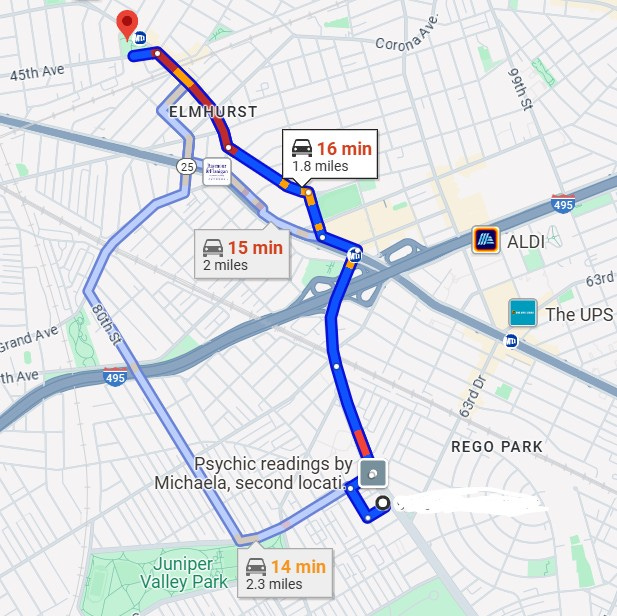When I began working on my family genealogy, one of my goals was to learn about my Moore heritage. I had heard a few stories from my grandfather about his father, but nothing definite about anyone earlier. My curiosity about the origins of my family was intense. After more than 20 years of searching, I finally discovered my great-grandfather’s parents. I’ve written about this discovery here. Once that brick wall tumbled down, the rest of the story came quickly.
These stories will introduce you to some of my Moore ancestors. I’m not sure if I believe in coincidence. But this story feels like my ancestors were jumping up and down and waving their arms to try to get my attention.
The first time I set foot in New York City was when I moved there on 28 December 1994. I needed a change in my life and some adventure, and I found it there. I stayed until I retired on 1 June 2016. Most of that time, I lived in an area of the city called Middle Village, Queens. Just 1.5 miles from my apartment was Moore Homestead Playground—a park I passed countless times during my years in Middle Village, Queens. You will understand the significance of this as my story unfolds.
Rev. John Moore
Rev. John Moore, my 11th great-grandfather and the founder of my American lineage, was born in Somerset, England, in 1620. He was baptized into the Church of England on 19 May 1620. The baptism record identifies his father as John Moore. It does not mention his mother.
John Moore first appears in the American colonies in 1641. He arrived in Lynn, Massachusetts Bay Colony, but promptly departed for Southampton, Long Island, not before marrying Margaret Howell, the daughter of Edward Howell of Boston and Lynn. Mr. Howell was the head of the colony that established Southampton.1
A town meeting was held in Southampton on 6 April 1641, to set out some of the rules governing the new settlement. Among them was a provision that spelled out “there shall be three planteing lotts laid out, abutting upon the Little Common appertayneing vnto each of the forty-eight Acres, vis: to Henry Symonds, the first lott, to Mr. Abraham Piersen the second Lott, and to John Moore, the third lott; yt being further ordered that the persons above mentioned shall be at the charge of fencing the says lotts, so much as they shall abutt vpon the little common.”2
This is the first indication of the influence John Moore would have over the Southampton settlement. There would be many more over the next several years.
In the following years, John played a vital role in the activities and development of the Southampton settlement. In 1644, Southampton agreed to be in union with the Connecticut Colony of Hartford. John was named one of the three representatives of Southampton to the colony. Later in that same year, John was appointed to raise fund to send scholars to be educated at Cambridge (current day Harvard College).3
John was one of the scholars sent by Southampton to study at Harvard. In 1646, he completed his studies and was granted a license to preach. He was not a regularly ordained minister at that time, so he could not administer sacraments. When he returned to Long Island, he moved to Hempstead to preach the gospel there.4
In 1652, John moved to the newly formed community of Newtown, Long Island, to become the first minister in the village.
As was common during this time period, there was a strong connection between the civil and religious life of the community. It was within this environment that the town’s first planner and leader, (Reverend) John Moore (c. 1620-1657), set up a local government and provided a system of taxes. He also conducted church services, taught school, and established liaisons with the Native Americans. Although this patriarch of the Moore family is sometimes identified as a minister, the record is unclear about an official ordination. Under John Moore’s leadership, the townspeople constructed a meetinghouse that served a variety of community and religious purposes as the schoolhouse, hall, church, and minister’s house. This common facility was financed by the townspeople and used cooperatively by everyone regardless of religious preference. It was not until the late 17th century that the townspeople began planning for the construction of church buildings for individual denominations.5
John’s tenure at the church in Newtown was relatively short. He is recognized as having been the minister from 1652 to 1657 when he died at the age of 37.6
John and Margaret Howell Moore were the parents of four sons and a daughter who will be introduced in the second part of this series.
James W. Moore, Rev. John Moore of Newtown, Long Island, and some of his Descendants (n.d.; image reprint, Delhi: Alpha Editions, 2019), 25.
Moore, Rev. John Moore of Newtown, Long Island, and some of his Descendants, 25.
Moore, Rev. John Moore of Newtown, Long Island, and some of his Descendants, 26.
First Presbyterian Church of Newtown, “John Moore (1652-1657),” fpcn.org website, http://www.fpcn.org/history/pastors/25-moore.
Landmarks Preservation Commission, City of New York, “Old Saint James Episcopal Church,” 19 September 2017, Designation List 498, LP-2593, https://s-media.nyc.gov/agencies/lpc/lp/2593.pdf, 4.
First Presbyterian Church of Newtown, “John Moore (1652-1957).







Also, I see that we only overlap a few years until John died. I anxiously await the next installment to find John's children my ancestors probably knew. (No Moores in my tree yet).
It appears that the Kranckheits did not use the meetinghouse John Moore began. They took their children to New Amsterdam to be baptized in the Dutch church there.
I do love the idea that we are connected to the places of our ancestors. Finding such early records of John Moore must have been thrilling. It's a shame he lived such a short life. Is there any part of the Old St. James Episcopal Church that remains?